An off-road sports car is normally the stuff of rallycross fever dreams. But at the premiere of the 2023 Porsche 911 Dakar on the eve of the Los Angeles auto show on Wednesday, company CEO Oliver Blume said, “We’re making our customers’ dreams come true.”
Indeed, the 911 Dakar is nothing short of rad, with its fixed rear spoiler, flared wheel arches, all-terrain tires and bright red tow hooks. The Dakar rides 2.0 inches higher than a base 911 Carrera, and a high-level mode increases ground clearance by another 1.2 inches. It’s not an air suspension setup, however; the Dakar uses separate hydraulic lifts at the front and rear. This gives the 911 Dakar a maximum ride height of 7.5 inches, along with respectable approach and breakover angles of 16.1 and 19.0 degrees, respectively. The high-level setting isn’t just for slow-speed off-roading, either; the 911 Dakar can drive like this at speeds up to 105 mph.
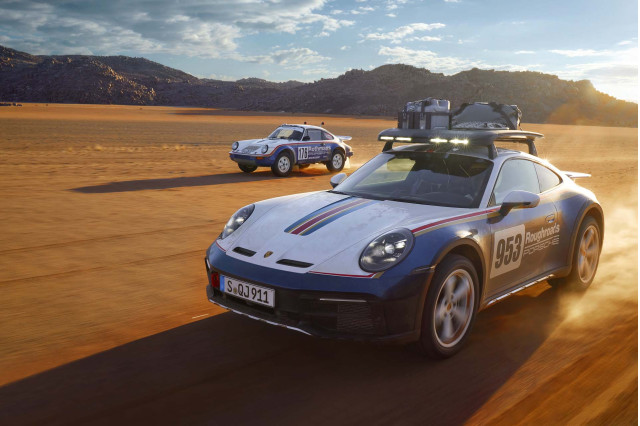 2023 Porsche 911 Dakar
2023 Porsche 911 Dakar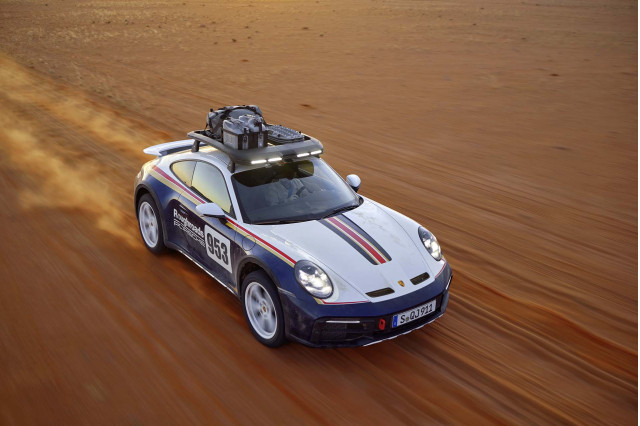 2023 Porsche 911 Dakar
2023 Porsche 911 Dakar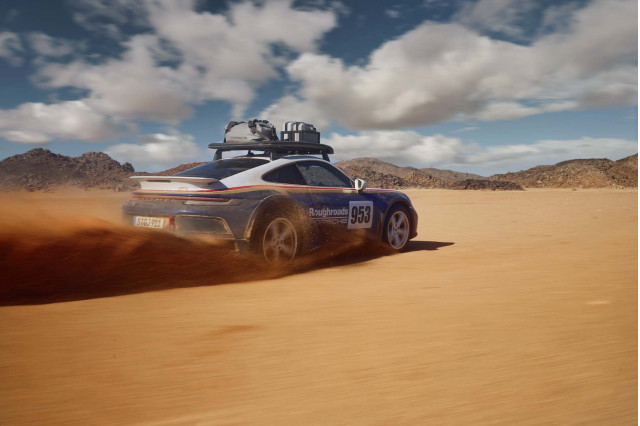 2023 Porsche 911 Dakar
2023 Porsche 911 DakarThe car is called the 911 Dakar rather than the 911 Safari as speculated. It has a new Rallye drive mode that gives the standard all-wheel-drive system a greater rear bias, and an Off-Road mode that automatically engages the higher ride height. The suspension itself has stronger dampers and longer links for increased wheel travel, and the standard steel brakes are borrowed from the Carrera S. Carbon-ceramic stoppers aren’t offered. Porsche also adds a Rallye Launch Control program for these two settings that allows for 20% more wheel spin than normal. This thing should look cool as heck when it kicks up dirt as it launches.
Porsche says the 911 Dakar can accelerate to 60 mph in 3.2 seconds, matching the time of a rear-wheel-drive Carrera GTS. The 911 Dakar shares its powertrain with the all-wheel-drive Carrera 4 GTS, meaning it uses a 3.0-liter twin-turbo flat-6 engine producing 473 hp and 420 lb-ft of torque, as well as an 8-speed dual-clutch automatic transmission. No, there will not be a manual option. The engine has more robust air filters and larger intercoolers borrowed from the 911 Turbo, which are necessary to mitigate the extra dust from off-roading.
Rear-wheel steering and active anti-roll bars are all standard equipment, as are Pirelli Scorpion All-Terrain Plus tires. The 245/45ZR-19 front and 295/40ZR-20 rear tires have a 9-mm tread depth, making them properly aggro, but Porsche says buyers can option Pirelli P Zero summer performance or winter tires if they wish. Because of the all-terrain tires, the 911 Dakar’s top speed is limited to 150 mph.
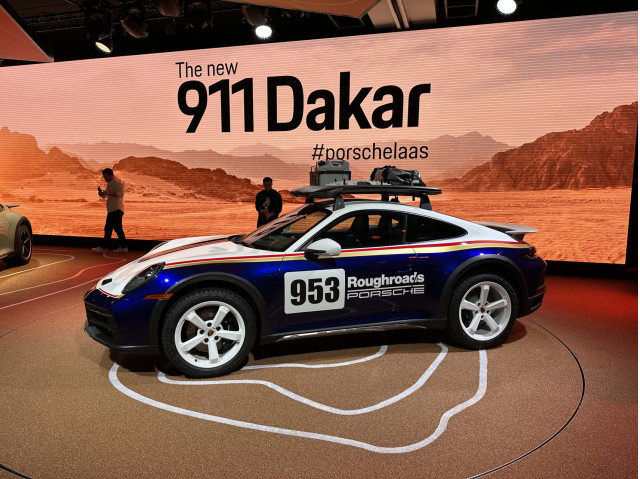 2023 Porsche 911 Dakar
2023 Porsche 911 Dakar 2023 Porsche 911 Dakar
2023 Porsche 911 Dakar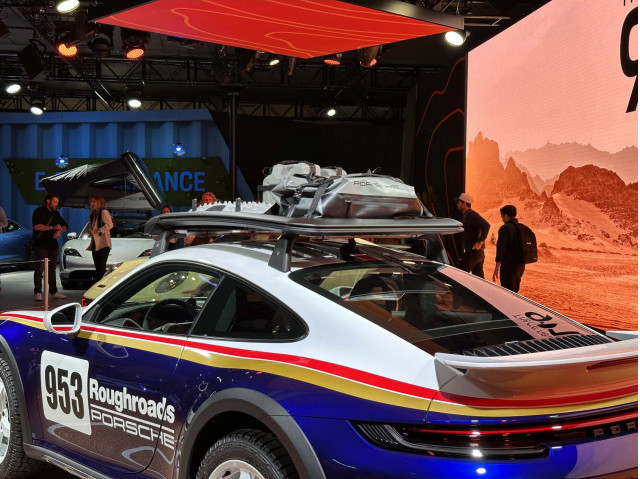 2023 Porsche 911 Dakar
2023 Porsche 911 DakarFor the adventurous who want to protect the underbody when bombing across the desert, the 911 Dakar has stainless steel plates on the front, rear, and side sills, and additional underbody protection is available through the Techquipment accessories catalog.
The Dakar’s carbon-fiber hood is ripped right from the GT3—ugly nostrils and all—and lightweight glass comes standard. At 3,552 pounds, the 911 Dakar is 16 pounds heavier than a 911 Carrera 4 GTS, with the deletion of the rear seats and the inclusion of full carbon-fiber front buckets helping to keep the weight down. Buyers can option more comfortable leather chairs, but the rear-seat delete is mandatory, since the rear hydraulic lift is housed under the floor.
Aside from a few other minor trim flourishes, the Dakar’s interior is unchanged from other 911s. European customers can add a Rallysport package that includes a roll cage, a six-point harness, and a fire extinguisher, but this won’t be available in the U.S.
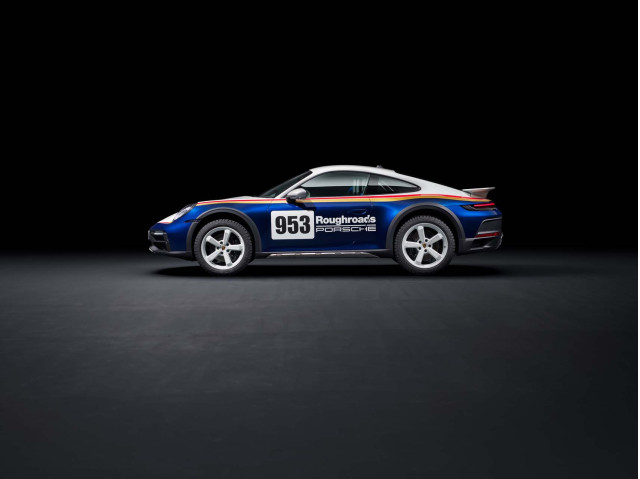 2023 Porsche 911 Dakar
2023 Porsche 911 Dakar
For those who like the look of the roof basket, good news, it’s available as an option, as is a roof tent. The Dakar has a 12-volt outlet for the auxiliary headlights on the roof rack, and the basket can hold up to 92 pounds of cargo while driving. This setup definitely looks good with the Rallye Design package that’s done up in white and Gentian Blue, paying homage to the Rothmans livery that adorned the original Carrera 4×4 that won the 1984 Paris-Dakar Rally.
“One of our greatest motorsport victories,” according to Blume.
Yes, the dirt-kickin’, mud-slingin’ 911 Dakar is finally a reality—albeit a very exclusive, very expensive one. Limited to just 2,500 units globally, the 2023 Porsche 911 Dakar will cost $223,450 (including $1,450 for destination) when it goes on sale next spring. That makes it more expensive than a 911 Turbo S and almost as pricey as the 911 GT3 RS. But then again, the Dakar is unlike any other 911 on the market today.—Steven Ewing
For more from the Los Angeles auto show, check out our dedicated hub.
Related Articles
- Fiat 500 returns to US in 2024 as pure EV
- 2024 Subaru Impreza loses manual and sedan, gains RS model
- 2023 Hyundai Ioniq 6 EV makes US debut at 2022 LA auto show
- Redesigned 2023 Toyota Prius ups performance, style
- Toyota bZ Compact SUV concept hints at electric C-HR successor





































